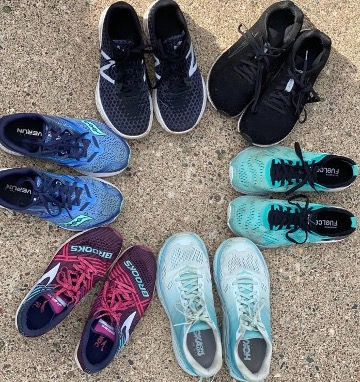Stretching: Does it Help or Hinder Running?
- Dr. Jamie Blumentritt, PT, DPT, CSCS

- Dec 11, 2020
- 4 min read
Updated: Nov 4, 2022

“Stretching is really good for runners”
“All runners should stretch after their runs”
These are statements I have heard throughout my ten years of running, but are these just general fads within the running community or does stretching actually help runners?
The short answer: The research does not support that static stretching improves running performance or helps to prevent injuries.
Now, the long answer:
Static stretching leads to the activation of a nervous system loop where our nerves impact how our muscles work. Essentially what they do is turn off the muscle that is being stretched in order to protect us from overstretching the muscle. Due to our nerves doing this, there are a number of ways static stretching impacts running.
So, how does static stretching impact our running? Static stretching before a run leads to reduced power, strength, and speed of contraction in those muscles (1,4). One study found that the power production was reduced by 28% (1)! This can be true for up to 120 minutes after stretching (1).
What about with running form and economy? There is very conflicting evidence for this, with most of it showing that static stretching is only helpful for those who truly lack joint mobility (2, 3, 4, 5) . For example, if you have a job where you sit all day, it is likely that you have shortened hip flexor muscles. Shortening of muscles occurs when we maintain a body position for long periods of time and then makes us feel tight when we try to lengthen those short muscles. With running, this could lead to people not having enough hip extension during their gait cycle so that their leg does not swing behind their body. But, for those of us who are able to move through a normal range of motion, stretching has not been shown to improve running form or economy (3).
Are there benefits to having stiff tissues? Stiff muscles and other tissues can actually be to a runner’s advantage because it means the muscles do not have to work as hard to stabilize the joint (2,3, 6)! If I stretch a lot, that means I am going to have a lot of available mobility while I run and my muscles are going to have to work really hard to stabilize my body to maintain good running form.
Running speed: Specifically for all-out speed training, static stretching before a run can impact the first part of a run and make it feel like you are working a lot harder than if you did not stretch (3).
Storing of elastic energy: For all of you that enjoy physics, you will appreciate this point. Making tissues looser may interfere with the free elastic energy we get when stiff tissues store energy from the ground, are then stretched, and then release the energy when we contract the muscles. Loose tissues are like a slinky. If you stretch a slinky and then let go of it, there is not much recoil. If you take a really tight spring, stretch it, and then let go, what happens? There is a strong recoil response. If we rely less on free elastic energy, that means our muscles have to work a lot harder to propel us forward (4,6).
What about prevention of injuries? Here is a quote from one systematic review: “Close examination of these studies, however, finds that stretching has not been shown to prevent injury. Instead, use of stretching as a prevention tool against sports injury has been based on intuition and unsystematic observation rather than scientific evidence” (5). There are even some theories that static stretching could INCREASE rates of injuries. There theories include: having less stability in our joints which leads to joints moving less efficiently, looser tissues are not able to absorb energy from the ground as well which could lead to injury, improper body mechanics resulting from loose joints which could lead to stretching ligaments too far, and increased pain tolerance due to the effects of stretching which could lead to tissue damage (5).
What about incorporating a warmup with stretching before a run? Doing a warm-up together with static stretching can increase general flexibility, but has not been shown to prevent muscle soreness (5). But, warm-up routines that incorporate strength and balance training along with stretching have shown some effectiveness with preventing knee and ankle injuries (5).
So, what should we do if our muscles feel tight? For most runners, they would benefit from putting more focus on strength training than stretching. There is a lot of research that supports the use of heavy strength training to improve performance. It can also help with preventing injury by creating strong tissues to support the large load that is placed on them while running. If you experience tight muscles after a run, it is likely due to the muscles being weak. Weak muscles are not able to manage the load that is placed on them while running, so will feel sore after runs. Roll those muscles out and start adding strength training into your weekly workout routine!
What questions do you have about stretching and strength training?
Research articles on stretching:
1. Prolonged static stretching does not influence running economy despite changes in neuromuscular function: https://pubmed.ncbi.nlm.nih.gov/18972248/
2. Flexibility and running economy in female collegiate track athletes:https://pubmed.ncbi.nlm.nih.gov/16230980/
3. Static Stretching Alters Neuromuscular Function and Pacing Strategy, but Not Performance during a 3-Km Running Time-Trial:https://pubmed.ncbi.nlm.nih.gov/24905918/
4. Does Stretching Improve Performance? A Systematic and Critical Review: https://pubmed.ncbi.nlm.nih.gov/15377965/
5. The Impact of Stretching on Sports Injury Risk: A Systematic Review of Literature:https://pubmed.ncbi.nlm.nih.gov/15076777/
6. Tendon Length and Joint Flexibility Are Related to Running Economy:https://pubmed.ncbi.nlm.nih.gov/21266930/




Comments